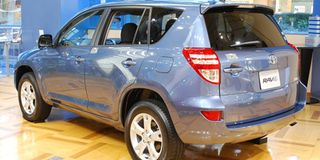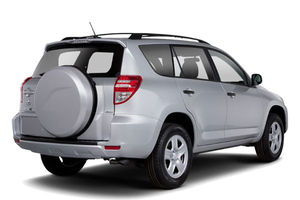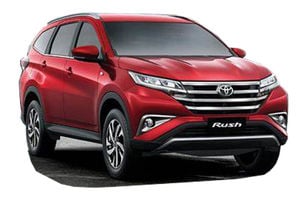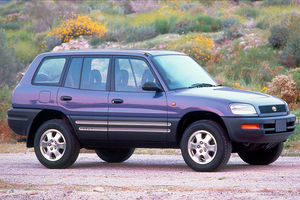
Even as a teenager, Richard Kaliisa was a big admirer of the Toyota Recreational Active Vehicle (RAV4) because of its strong body. He also found it to be simple, fairly small but also with a raised ground clearance to drive upcountry, especially in Bushenyi District, where his village home is located.
When Kaliisa graduated from Makerere University in 2010, it took him approximately four years to buy his first car. He drove a Toyota Corolla, then locally known as Kikumi for three years. After the Corolla, he bought a Toyota Premio. In late 2022, he purchased the car he had always dreamed of; a black Toyota RAV4 2008 model.
“I wanted the 2000 model (of the RAV) but they were already out of production and no longer on the market because of the ban on importation of old cars. The only ones on sale I came across had locally been driven and I was hesitant because I was not sure of their mechanical condition. I saved until I was ready to go to the bond for a fairly new RAV4,” Kaliisa says.
In the first few months, Kaliisa enjoyed his RAV4 and drove it to different upcountry places for weekend getaway trips. Unfortunately, what started as a likeable car turned out to be a nightmare.
“It had low engine power. If I was to accelerate, I would have to increase the acceleration force. If you are a driver who likes speed, it is not the car to buy. When I made inquiries from friends who drove similar cars, I told I should have bought the 2009 model and those made after,” Kaliisa recalls.
“It had also started consuming a lot of fuel. I would refuel with Shs50,000 from my home in Kyanja, Kampala, to my workplace in Luzira (a distance of about 14.1 km), and this fuel would only take me one way. I would have to refuel on my way back home. Even with a full tank of fuel, I would always find myself without fuel in just a short time,” he adds.
The deal breaker was when a full tank only lasted a week, yet Kaliisa had not driven the car for distances longer than his home and workplace.
He had only made stopovers at Luzira, a Kampala suburb. Approximately three months ago, in the week he painfully decided to sell off the 2500cc engine-powered RAV4, he had spent Shs250,000 on fuel. This, to Kaliisa, was comparatively worrying because a motorist with a Toyota Harrier that runs on a 2400cc engine cannot spend the same amount on fuel in the same period even if they commuted from Najjeera to Kampala City centre.
“I liked the car for its spacious interior and comfort while driving for long distances but I had to let it go. It is a car you can drive from Kampala to Mbarara in western Uganda with no need to stop and rest. Its legroom and the space between the driver’s head and the roof could comfortably accommodate drivers of any height. Its interior was also not exaggerated and it had several storage pockets,” Kaliisa says.
Costly maintenance
The service and maintenance costs of the RAV4 had also ceased to be stable. For instance, during one of his garage visits, Kaliisa spent Shs270,000 at one of the Total fuel stations in Kampala. On the next service routine that comes after covering 5,000km, he spent Shs320,000. The mileage was shy of a few kilometres for the third garage visit when he decided to part ways with the car.
Like most motorists normally do, especially with second-hand used cars bought from the bonds that are ignorantly considered new by many, when Kaliisa had just acquired the RAV, he drove it for a short time and it started making squeaking sounds. He replaced shock absorbers and brakes and it cost him Shs600,000. Unfortunately, the sounds did not go away.
When he visited his family mechanic after getting tired of roaming different garages, he was informed that the parts that had been earlier replaced were not of good quality. On average, he spent approximately Shs2.5m to have the car in safe condition because there were several other repairs, except the annoying fuel consumption costs.
Specs
Built with a 2500cc petrol engine, the RAV4 is a five-seater crossover. Like most cars of its classification, if the trunk is small and you want more luggage room, the rear passenger seats do flatly recline to create space.
When it comes to the entertainment system, on a scale of 10, Kaliisa rates the RAV4 at seven. Its inbuilt speakers are well amplified and do not require the installation of external speakers for better sound output.
Like most Japanese cars, the only downside with the entertainment system is that the radio that comes with most of these cars does not support Ugandan frequency modulation stations. You have to spend approximately Shs400,000 or more to get a radio that allows the use of many stations.
Review
The RAV4 is an adequate around-town driver, handling more like the car from which its platform is derived than a traditional SUV. Power is on the low side, however. It offers some initial pep when pulling away from stoplights, but any serious attempt at acceleration results in nothing more than noise and vibration. The engine gets particularly obnoxious above 4,500 rpm where underhood clatter is enough to stifle conversation between passengers. This would be more acceptable if accompanied by even a modest form of forward thrust. Unfortunately, it’s not.
The interior is not a bad place to spend time. The ventilation controls are easy to understand, the stereo outstanding, and the individual bucket seats are quite comfortable. Even with the rear seat up, cargo space is a healthy 26.8 cubic feet. Fold down the second seat and that number jumps to 57.9 «moving-into-my-first-dorm-room» cubic feet. Adults placed in back will most likely whine about a lack of legroom, however.-
Source: www.edmunds.com




